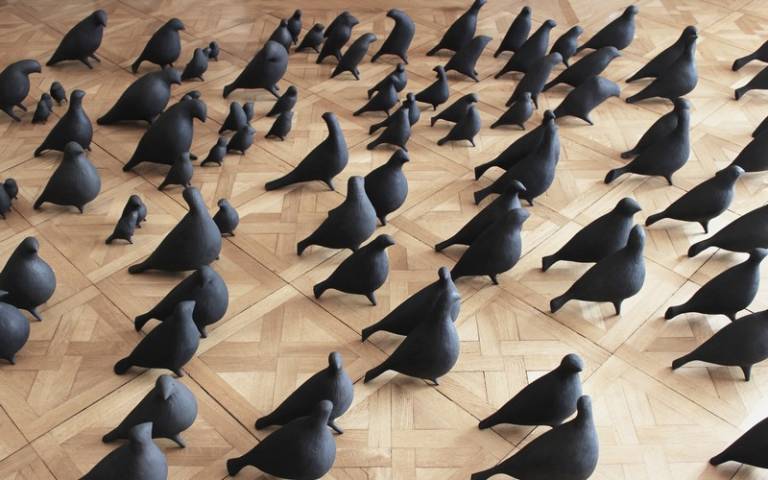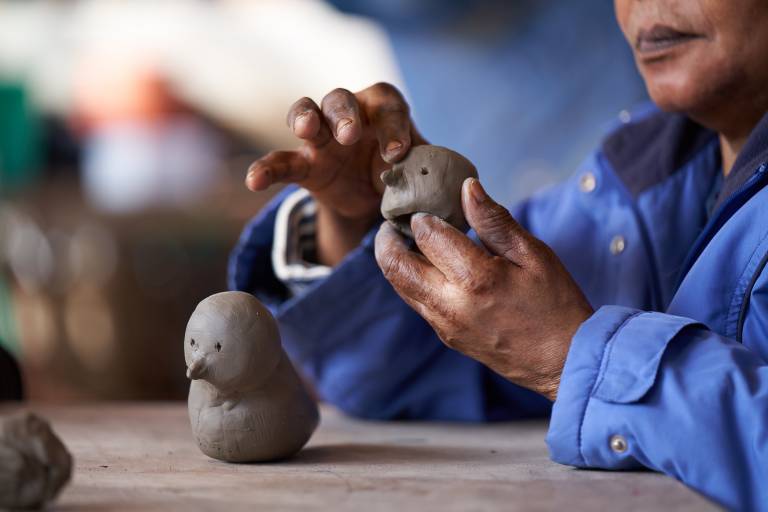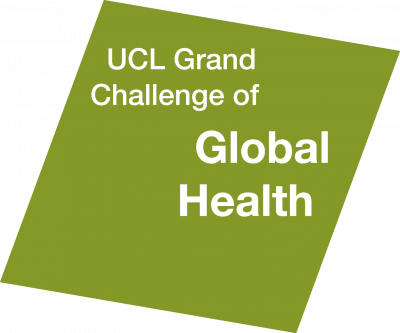Flock: Non-Clinical Art Interventions for Wellbeing and Belonging
Flock: Non-Clinical Art Interventions for Wellbeing and Belonging among refugee, asylum seeker and displaced migrant populations.

2 October 2018
As part of UCL Grand Challenge’s initiative on Migration and Displacement, funding was awarded to Dr Humera Iqbal, Dr Katie Quy, and Professor Helen Chatterjee for the project: “Flock: Non-Clinical Art Interventions for Wellbeing and Belonging among refugee, asylum seeker and displaced migrant populations”. The team at UCL collaborated with artist Julie Nelson, occupational therapist Helen Shearn, and colleagues at the South London and Maudsley NHS Foundation Trust (SLaM Grounding Project) to learn more about the effectiveness of non-clinical art-creation based interventions on mental health in displaced migrant populations, and produce two exhibitions showcasing art produced and detailing the journeys of the participants.
Lindsay Swan, PR volunteer for the Grounding Project, reports on the project.

Art by Julie Nelson. Photo by Ben Wright.

From a distance, the flock of ceramic birds in the Lewisham Arthouse Project Space could be pigeons congregating in search of food. But get closer and each of the 200 plus birds in the Flock Project installation is different, each made by different hands, sometimes working together, each telling a story of loss, migration and, importantly, of hope.
The birds have been made by members of the Grounding project, which supports those with Post Traumatic Stress Disorder, particularly asylum seekers, refugees and displaced people, through therapeutic activities including gardening and crafts. Flock is the creation of artist Julie Nelson and the exhibition is the result of workshops with members of the Grounding group, which started in early 2019 and have included events for Refugee Week at the V&A.
Focusing on birds as a subject for the installation has enabled the participants to express themselves in a subject that is ever present even in the city and Julie’s inspiration came from starling murmurations. The project has helped to connect participants with the environment, increase awareness of birds and the sometimes difficult journeys they make. Says Julie, “One interesting result of the project has been the diverse styles and forms of birds that have been made. When I’ve researched birds from Ethiopia, Syria and Iraq, for example, I can see where the inspiration comes from. I think that having a common goal of the exhibition has really helped.”
“The workshop has been a focus for people to think about the metaphor of birds and to engage with nature and the environment,” explains Julie. “We encourage shared production, so that a clay pinched head may attach to a press moulded body created by someone else in the group.”

The impact of the Flock project is being evaluated by Dr Humera Iqbal, Associate Professor of Social and Cultural Psychology, and her colleagues at University College London, who supported the Flock Project as part of their Grand Challenges Fund. Some of the benefits noted so far include improved confidence and self-esteem. Working together encourages people to try something new and learn from each other and the joint project connects to other communities.
With social prescribing now high on the political and social care agenda, Flock Project serves as a positive response to current issues on mental health and recovery. Explains Humera, “We know from research that participating in cultural activities can improve wellbeing and combat loneliness in individuals. It has been great to witness first-hand the healing power of clay. Our ceramic birds stand for a shared community and a sense of resilience; they have been able to battle the odds, just like their makers.”
Working with the clay has been therapeutic for Rita* who suffers from arthritis. It helps her to move her fingers and reminds her of her former home. She spent a lot of time moulding out her bird, explaining, “Playing with this clay takes me back to my childhood in Africa when we used to pull clay from the rocks and make pots and plates. It was a fun time.”
“I used to have many of these as pets and I know how intelligent they are, “says Daris* who kept homing pigeons back in his country. “I am really enjoying learning more about birds and working with the clay”.
*Names have been changed
 Close
Close


